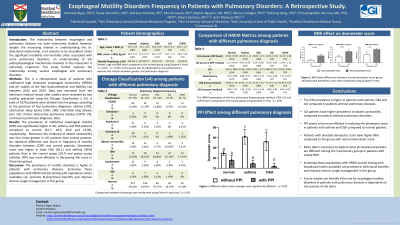Back


Poster Session E - Tuesday Afternoon
Category: Esophagus
E0187 - Esophageal Motility Disorders Frequency in Patients With Pulmonary Disorders: A Retrospective Study
Tuesday, October 25, 2022
3:00 PM – 5:00 PM ET
Location: Crown Ballroom

Has Audio

Mariana Nigro, PhD
Hartford Hospital
Fairfield, CT
Presenting Author(s)
Mariana Nigro, PhD1, Tijana Samardzic, MD2, Mariana Almeida, MS3, Marina Gaeta, MD4, Mytien Nguyen, MS, MSc3, Maria Ciarleglio, PhD5, Yanhong Deng, PhD5, Thiruvengadam Muniraj, MD, PhD3, Mayra Sanchez, MD6, Amir Masoud, MD6
1Hartford Hospital, Fairfield, CT; 2Yale-Waterbury Internal Medicine Residency Program, Waterbury, CT; 3Yale University School of Medicine, New Haven, CT; 4NYU Grossman School of Medicine, New York, NY; 5Yale University School of Public Health, New Haven, CT; 6Hartford Healthcare Medical Group, Fairfield, CT
Introduction: The relationship between esophageal and pulmonary diseases has been extensively studied, however, despite the increasing interest in understanding this bi-directional relationship, a lot remains to be elucidated. Given the significant morbidity and mortality often associated with some pulmonary disorders, an understanding of the pathophysiological mechanisms involved in this interaction is extremely important. This study further explores the relationship among various esophageal and pulmonary disorders.
Methods: This is a retrospective study of patients who underwent high resolution esophageal manometry (HREM) and pH studies at the Yale Gastrointestinal and Motility Lab between 2016 and 2019. Data was extracted from the electronic medical record after studies were reviewed by two motility specialists using the Chicago Classification v. 4.0. A total of 1078 patients were divided into five groups according to the presence of four pulmonary diagnoses: asthma (270); obstructive sleep apnea (OSA, 160); interstitial lung disease (ILD, 59); chronic obstructive pulmonary disease (COPD, 74); control (no pulmonary diagnosis, 565).
Results: The prevalence of ineffective esophageal motility (IEM) was significantly higher in ILD, asthma, and OSA patients compared to control (22.7, 18.5, 20.0 and 12.9%, respectively). Moreover, the incidence of absent contractility was four times greater in ILD patients than control patients. No statistical difference was found in frequency of motility disorders between COPD and control patients. Demeester score was higher in both OSA (36.1) and asthma (40.9) patients than in the control group (24.7) and proton pump inhibitor (PPI) was more effective in decreasing the score in these two groups.
Discussion: The prevalence of motility disorders is higher in patients with pulmonary diseases. Screening those populations with HREM and pH testing with impedance (when available) can promote bi-directional benefits and improve chronic cough management in this group.
Disclosures:
Mariana Nigro, PhD1, Tijana Samardzic, MD2, Mariana Almeida, MS3, Marina Gaeta, MD4, Mytien Nguyen, MS, MSc3, Maria Ciarleglio, PhD5, Yanhong Deng, PhD5, Thiruvengadam Muniraj, MD, PhD3, Mayra Sanchez, MD6, Amir Masoud, MD6. E0187 - Esophageal Motility Disorders Frequency in Patients With Pulmonary Disorders: A Retrospective Study, ACG 2022 Annual Scientific Meeting Abstracts. Charlotte, NC: American College of Gastroenterology.
1Hartford Hospital, Fairfield, CT; 2Yale-Waterbury Internal Medicine Residency Program, Waterbury, CT; 3Yale University School of Medicine, New Haven, CT; 4NYU Grossman School of Medicine, New York, NY; 5Yale University School of Public Health, New Haven, CT; 6Hartford Healthcare Medical Group, Fairfield, CT
Introduction: The relationship between esophageal and pulmonary diseases has been extensively studied, however, despite the increasing interest in understanding this bi-directional relationship, a lot remains to be elucidated. Given the significant morbidity and mortality often associated with some pulmonary disorders, an understanding of the pathophysiological mechanisms involved in this interaction is extremely important. This study further explores the relationship among various esophageal and pulmonary disorders.
Methods: This is a retrospective study of patients who underwent high resolution esophageal manometry (HREM) and pH studies at the Yale Gastrointestinal and Motility Lab between 2016 and 2019. Data was extracted from the electronic medical record after studies were reviewed by two motility specialists using the Chicago Classification v. 4.0. A total of 1078 patients were divided into five groups according to the presence of four pulmonary diagnoses: asthma (270); obstructive sleep apnea (OSA, 160); interstitial lung disease (ILD, 59); chronic obstructive pulmonary disease (COPD, 74); control (no pulmonary diagnosis, 565).
Results: The prevalence of ineffective esophageal motility (IEM) was significantly higher in ILD, asthma, and OSA patients compared to control (22.7, 18.5, 20.0 and 12.9%, respectively). Moreover, the incidence of absent contractility was four times greater in ILD patients than control patients. No statistical difference was found in frequency of motility disorders between COPD and control patients. Demeester score was higher in both OSA (36.1) and asthma (40.9) patients than in the control group (24.7) and proton pump inhibitor (PPI) was more effective in decreasing the score in these two groups.
Discussion: The prevalence of motility disorders is higher in patients with pulmonary diseases. Screening those populations with HREM and pH testing with impedance (when available) can promote bi-directional benefits and improve chronic cough management in this group.
Disclosures:
Mariana Nigro indicated no relevant financial relationships.
Tijana Samardzic indicated no relevant financial relationships.
Mariana Almeida indicated no relevant financial relationships.
Marina Gaeta indicated no relevant financial relationships.
Mytien Nguyen indicated no relevant financial relationships.
Maria Ciarleglio indicated no relevant financial relationships.
Yanhong Deng indicated no relevant financial relationships.
Thiruvengadam Muniraj indicated no relevant financial relationships.
Mayra Sanchez indicated no relevant financial relationships.
Amir Masoud indicated no relevant financial relationships.
Mariana Nigro, PhD1, Tijana Samardzic, MD2, Mariana Almeida, MS3, Marina Gaeta, MD4, Mytien Nguyen, MS, MSc3, Maria Ciarleglio, PhD5, Yanhong Deng, PhD5, Thiruvengadam Muniraj, MD, PhD3, Mayra Sanchez, MD6, Amir Masoud, MD6. E0187 - Esophageal Motility Disorders Frequency in Patients With Pulmonary Disorders: A Retrospective Study, ACG 2022 Annual Scientific Meeting Abstracts. Charlotte, NC: American College of Gastroenterology.
